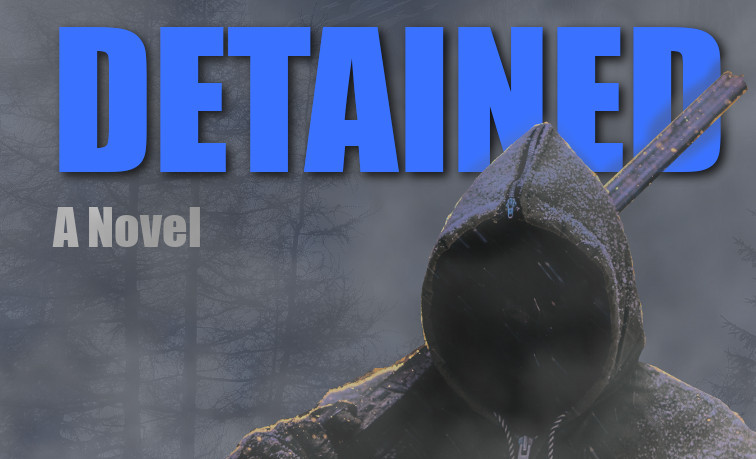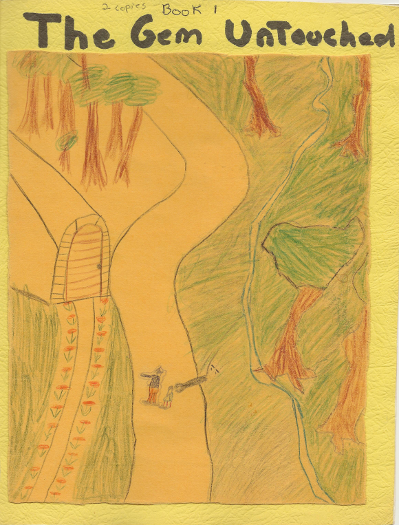Detained Chapter 9

I’ll be posting one chapter of my novel Detained every week throughout 2021. Download links below!
9. Candace
For a moment, she thought it had all gone to hell. Jimmy followed up his sucker punch with a rebel yell and leaped down onto Mike, fists swinging, and the rest of the place devolved into chaos. The soldiers surged forward, but before they could get to the pair, Mike somehow scissored his legs, gained some leverage, and flipped Jimmy over onto his back. Jimmy then rolled away as Mike pounced, sprang to his feet, and crashed into Jimmy, knocking over tables.
She’d seen Jimmy Haggen get into fights before—plenty of times. He didn’t have any particular training or style; he was a scrapper. He had a lean, natural athleticism that made him a dangerous opponent, but he relied entirely on his reflexes and speed—and an ability to take a punch.
Mike, though, looked like he’d trained somewhere. He wasn’t boxing, his whole center of gravity had shifted. He kept shifting away from Jimmy, then leaning in with lightning speed and landing a blow before dancing back again. Dancing, she thought. It was exactly like he was dancing with Jimmy.
Jimmy was getting the worst of it, though; Mike touched him regularly and he seemed unable to get past Mike’s defenses. Haggen didn’t seem to mind; his smile was constant. She realized they were putting on a performance, because whenever one of the soldiers made a move as if to break them up, they suddenly locked into each other and crashed into another part of the bar, where they resumed their odd dance.
When Hammond stormed from behind past her, she was startled out of her trance. The colonel, tall and cool and more or less the definition of unamused, walked about three steps past her and stood for a moment with her arms akimbo, her back ramrod straight.
Going over the list of things to look up that she and Mike had quickly compiled, she took a step backwards, eyes locked on Hammond, then spun and moved as swiftly and silently as she could down the hall. She’d taken this route a million times, during endless boring nights when literally no one had come into the place before ten at night, but it suddenly seemed sinister and foreign, as if Hammond and her people had taken it from them after their invasion.
She ducked into the office, forcing herself to not look back. She could hear the fight, and she hadn’t yet heard Hammond give any order to shut it down. She told herself that as long as Jimmy and Mike kept it up, she had time.
She slid into the chair and turned on the old monitor; the plastic casing had once been beige but had soured into something yellower over the years. It hummed and took a while to warm up, but the moment the screen slowly began to fade into being she was moving the mouse, clicking on the dial-up icon.
When she’d first started working at Jack’s, she’d been stunned to discover that there was no high-speed Internet, no satellite television, and only this wheezing old relic of a computer. The jukebox hadn’t been serviced or updated in years, and the furniture and decorations were exactly what Jack had inherited from old Catfish Lowell, which Lowell himself had inherited decades earlier. She knew she had never been the hippest or coolest girl in the world (and knew that even the coolest girl in this tiny town wouldn’t even make the list in a big city), but even so the complete disinterest Jack McCoy had in modernizing the place was disturbing.
And the most disturbing aspect by far was the dialup. Before working at the bar, Candace had retained vague, watery memories of dialup Internet, and those memories were unhappy ones. When Jack had painstakingly walked her through the process, she’d been amazed that this was how people had once gotten on the Internet. How she herself had once done it, though she didn’t think she’d had to wait through the screeching modem noises since High School, at the latest. She was doubly amazed that it was still possible, but Jack assured her millions of people still used dialup Internet. She was then not amazed, but rather horrified, at the speed dialup offered. It was like reading a book with someone feeding you one letter at a time from a very great distance.
The login box appeared, with Jack’s user name and the starred-out password already filled in. The modem roared into tinny life with the now-familiar burps and screeches of data over a phone line, and her heart leaped: It seemed incredibly loud in Jack’s tiny, overstuffed office. Her heart racing, she danced in the chair as the handshake completed and the computer announced she was connected.
She clicked on the text-only browser she’d installed a few years back. It ignored all graphics and other elements and rendered every page solely as text. She’d installed it out of desperation after the old computer kept freezing every time she tried to load any web page that had been created within the last five years—the text-only browser meant she wasn’t getting the most fun aspects of the Internet, but at least she was able to read the news and gossip without growing old in the process.
The browser window appeared, no-frills, just a white box with an input line. The fight continued to rage outside. She typed a news site she liked to visit into the box and hit the enter key. She’d discussed it with Mike, and they’d agreed if something worldwide or even nationwide was happening, it made sense to start with that. She held her breath as the modem crunched bits and the browser waited. Then the page started trickling in, one line of text at a time. There was nothing. A football player had been in a car crash and fled the scene. Someone in Atlanta had called in a bomb threat to a church. Russia had sent troops into the Arctic again, but nothing about it seemed urgent.
Not a general event, she thought. Unless they’re suppressing it. She felt foolish for thinking such a paranoid thought, then regrouped. Jesus, we’re being detained mysteriously by troops, she thought. If there was ever a time to be paranoid, this is it.
She pulled up a search engine and typed RASLOWSKI DOCTOR Ph.D. M.D. into the search box. Mike thought that since he was the only non-military person in the group, there might be more on him out there.
She heard Hammond shouting, and nearly jumped out of the seat. The text came scrolling onto the screen; the first few hits were generic ones for doctor-related websites, then an encyclopedia entry. The next few seemed innocuous: Local doctor offices in far-away places, or ratings websites giving reviews for local doctors.
The eighth hit caught her eye; it was a news item, titled PHYSICIST LEAVES UNDER CLOUD. The brief snippet beneath the headline began “Dr. Emory Raslowski resigned his position as senior scientist at.”
She clicked on the link just as Hammond shouted again.
“King and Williams! Stop holding your junk and separate these men!”
The screen filled with minimally-formatted text: Dr. Emory Raslowski resigned his position as senior scientist at the Holzman Institute Monday. Dr. Raslowski, regarded as one of the leading theoretical physicists in the world, has been under investigation by the compliance committee for alleged ethics violations in research programs under his direct supervision. Dr. Raslowski has so far offered no comment on the accusations, and today announced via memorandum that he would be vacating his position. He would not specify what, if any, new position he had accepted, responding to queries only with an emailed “No comment.”
The noise in the next room became suddenly louder, and Candace imagined soldiers getting involved, which meant that Mike and Jimmy were now actively risking their lives. She opened the regular browser and counted the four heartbeats it took to grind through its boot process on the ancient computer, then typed the same search in. She clicked the link and waited another agonizing few seconds while the old browser sorted itself out, the web page appearing in jerky increments as the lights on the old modem danced.
Suddenly, the chaos outside stopped. She could hear Hammond speaking in much more controlled voice. Her heart was pounding. There wasn’t much time.
There was a photo, halfway down the screen. It appeared one scanned line at a time, and she leaned forward, willing it to resolve into something she could comprehend. Line by line, the photo grew like it was being hand-stippled on the screen by unseen hands. When it was halfway finished she knew it was Raslowski, but despite the ominous silence outside and her shaking hands, she forced herself to wait a few seconds more, and then a few seconds more, until it was absolutely him, the same mild-looking man in the same dark plastic glasses, scowling at her from the screen.
“King, if these men so much as make a noise, gag them and handcuff them to the bar,” Hammond bellowed.
Oh, fuck, Candace thought.
Frantically, she leaped up. Without thinking, she dashed forward and slid behind the open door, hiding in the darkness between it and the wall. A second later, Hammond stepped into the office.
Candace closed her eyes. How long could she stand there, how long could she stay silent? What if the colonel wanted some privacy and closed the door? She ran through possible scenarios, reactions. What would be her excuse? Why was she in the office? What justification could she offer?
Suddenly there was another commotion outside, with raised voices that quickly swelled in volume. She heard the colonel hiss a curse under her breath, and then heard her storm out of the office again.
Immediately, she stepped back out from behind the door and with a deep breath she walked out into the hallway. She felt hidden for a moment in the relative gloom of the hallway, but as she approached the bar area again she felt increasingly exposed. Everyone was paying attention to Jimmy, who was being restrained by two soldiers, thrashing about and shouting.
“Fuck you!” he shouted. “This is the United States of America and I demand to be allowed to make a god-damn phone call!”
She held her breath as she approached the line that divided the well-lit bar from the dark hallway. She realized that Jimmy was staring at her as she crept forward.
“You can’t do this! I’m going to fucking own you when I get my lawyer on the line!”
She slipped into the light and leaned back against the wall. A moment later their eyes locked, and he winked at he, then slumped, breathing hard.
“All right,” he said. “I’m done.”





